Investigation of Causal Relationships between Printing Parameters, Pore Properties and Porosity in Laser Powder Bed Fusion
Abstract
1. Introduction
2. Materials and Methods
2.1. Design of Experiment
2.2. Printing Strategy
2.3. Pore Properties and Porosity Measurement
3. Results and Discussion
3.1. Reliability of XCT and Optical Method
3.2. Pore Properties Analysis
3.3. Porosity Analysis
3.4. Prediction and Optimization of Porosity
4. Conclusions
Author Contributions
Funding
Institutional Review Board Statement
Informed Consent Statement
Data Availability Statement
Acknowledgments
Conflicts of Interest
References
- Chowdhury, S.; Yadaiah, N.; Prakash, C.; Ramakrishna, S.; Dixit, S.; Gupta, L.R.; Buddhi, D. Laser powder bed fusion: A state-of-the-art review of the technology, materials, properties & defects, and numerical modelling. J. Mater. Res. Technol. 2022, 20, 2109–2172. [Google Scholar]
- Tang, M.; Pistorius, P.C.; Beuth, J.L. Prediction of lack-of-fusion porosity for powder bed fusion. Addit. Manuf. 2017, 14, 39–48. [Google Scholar] [CrossRef]
- du Plessis, A.; Yadroitsava, I.; Yadroitsev, I. Effects of defects on mechanical properties in metal additive manufacturing: A review focusing on X-ray tomography insights. Mater. Des. 2020, 187, 108385. [Google Scholar] [CrossRef]
- du Plessis, A. Effects of process parameters on porosity in laser powder bed fusion revealed by X-ray tomography. Addit. Manuf. 2019, 30, 100871. [Google Scholar] [CrossRef]
- Spierings, A.B.; Schneider, M.; Eggenberger, R. Comparison of density measurement techniques for additive manufactured metallic parts. Rapid Prototyp. J. 2011, 17, 380–386. [Google Scholar] [CrossRef]
- de Terris, T.; Andreau, O.; Peyre, P.; Adamski, F.; Koutiri, I.; Gorny, C.; Dupuy, C. Optimization and comparison of porosity rate measurement methods of Selective Laser Melted metallic parts. Addit. Manuf. 2019, 28, 802–813. [Google Scholar] [CrossRef]
- Cakmak, E.; Bingham, P.; Cunningham, R.W.; Rollett, A.D.; Xiao, X.; Dehoff, R.R. Non-destructive characterization of additively manufactured components with x-ray computed tomography for part qualification: A study with laboratory and synchrotron x-rays. Mater. Charact. 2021, 173, 110894. [Google Scholar] [CrossRef]
- Ziółkowski, G.; Chlebus, E.; Szymczyk, P.; Kurzac, J. Application of X-ray CT method for discontinuity and porosity detection in 316L stainless steel parts produced with SLM technology. Arch. Civ. Mech. Eng. 2014, 14, 608–614. [Google Scholar] [CrossRef]
- Chioibasu, D.; Mihai, S.; Mahmood, M.A.; Lungu, M.; Porosnicu, I.; Sima, A.; Dobrea, C.; Tiseanu, I.; Popescu, A.C. Use of X-ray Computed Tomography for Assessing Defects in Ti Grade 5 Parts Produced by Laser Melting Deposition. Metals 2020, 10, 1408. [Google Scholar] [CrossRef]
- Yusuf, S.M.; Chen, Y.; Boardman, R.; Yang, S.; Gao, N. Investigation on Porosity and Microhardness of 316L Stainless Steel Fabricated by Selective Laser Melting. Metals 2017, 7, 64. [Google Scholar] [CrossRef]
- Wits, W.W.; Carmignato, S.; Zanini, F.; Vaneker, T.H.J. Porosity testing methods for the quality assessment of selective laser melted parts. CIRP Ann. 2016, 65, 201–204. [Google Scholar] [CrossRef]
- Heim, K.; Bernier, F.; Pelletier, R.; Lefebvre, L.P. High resolution pore size analysis in metallic powders by X-ray tomography. Case Stud. Nondestruct. Test. Eval. 2016, 6, 45–52. [Google Scholar] [CrossRef]
- Vilaro, T.; Colin, C.; Bartout, J.D. As-Fabricated and Heat-Treated Microstructures of the Ti-6Al-4V Alloy Processed by Selective Laser Melting. Metall. Mater. Trans. A 2011, 42, 3190–3199. [Google Scholar] [CrossRef]
- Kan, W.H.; Nadot, Y.; Foley, M.; Ridosz, L.; Proust, G.; Cairney, J.M. Factors that affect the properties of additively-manufactured AlSi10Mg: Porosity versus microstructure. Addit. Manuf. 2019, 29, 100805. [Google Scholar] [CrossRef]
- Gong, H.; Rafi, K.; Gu, H.; Starr, T.; Stucker, B. Analysis of defect generation in Ti–6Al–4V parts made using powder bed fusion additive manufacturing processes. Addit. Manuf. 2014, 1–4, 87–98. [Google Scholar] [CrossRef]
- Choo, H.; Sham, K.-L.; Bohling, J.; Ngo, A.; Xiao, X.; Ren, Y.; Depond, P.J.; Matthews, M.J.; Garlea, E. Effect of laser power on defect, texture, and microstructure of a laser powder bed fusion processed 316L stainless steel. Mater. Des. 2019, 164, 107534. [Google Scholar] [CrossRef]
- Kluczyński, J.; Śnieżek, L.; Grzelak, K.; Mierzyński, J. The Influence of Exposure Energy Density on Porosity and Microhardness of the SLM Additive Manufactured Elements. Materials 2018, 11, 2304. [Google Scholar] [CrossRef] [PubMed]
- Montgomery, D.C. Design and Analysis of Experiments, 8th ed.; John Wiley & Sons, Inc.: Hoboken, NJ, USA, 2012. [Google Scholar]
- Aggarwal, A.; Patel, S.; Kumar, A. Selective Laser Melting of 316L Stainless Steel: Physics of Melting Mode Transition and Its Influence on Microstructural and Mechanical Behavior. JOM 2019, 71, 1105–1116. [Google Scholar] [CrossRef]
- Kasperovich, G.; Haubrich, J.; Gussone, J.; Requena, G. Correlation between porosity and processing parameters in TiAl6V4 produced by selective laser melting. Mater. Des. 2016, 105, 160–170. [Google Scholar] [CrossRef]
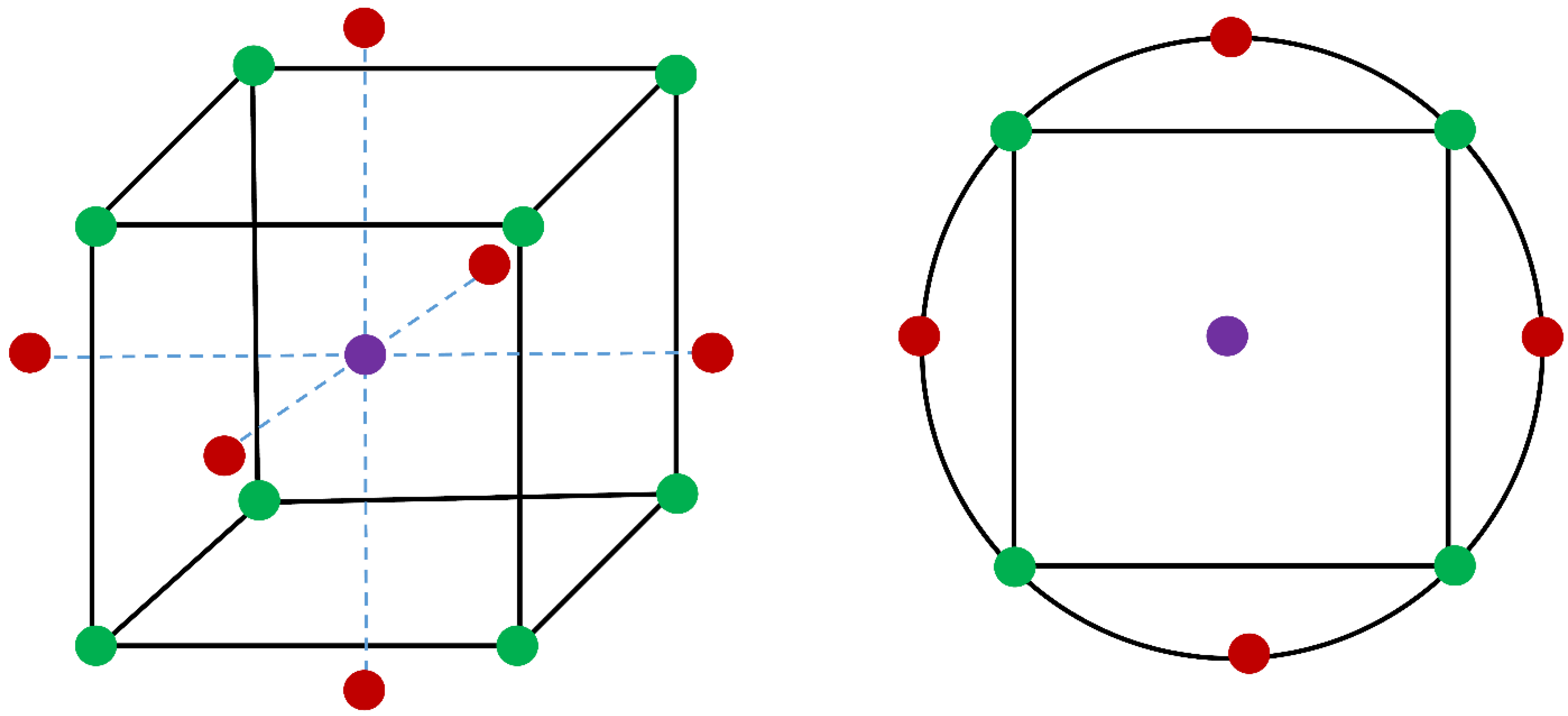
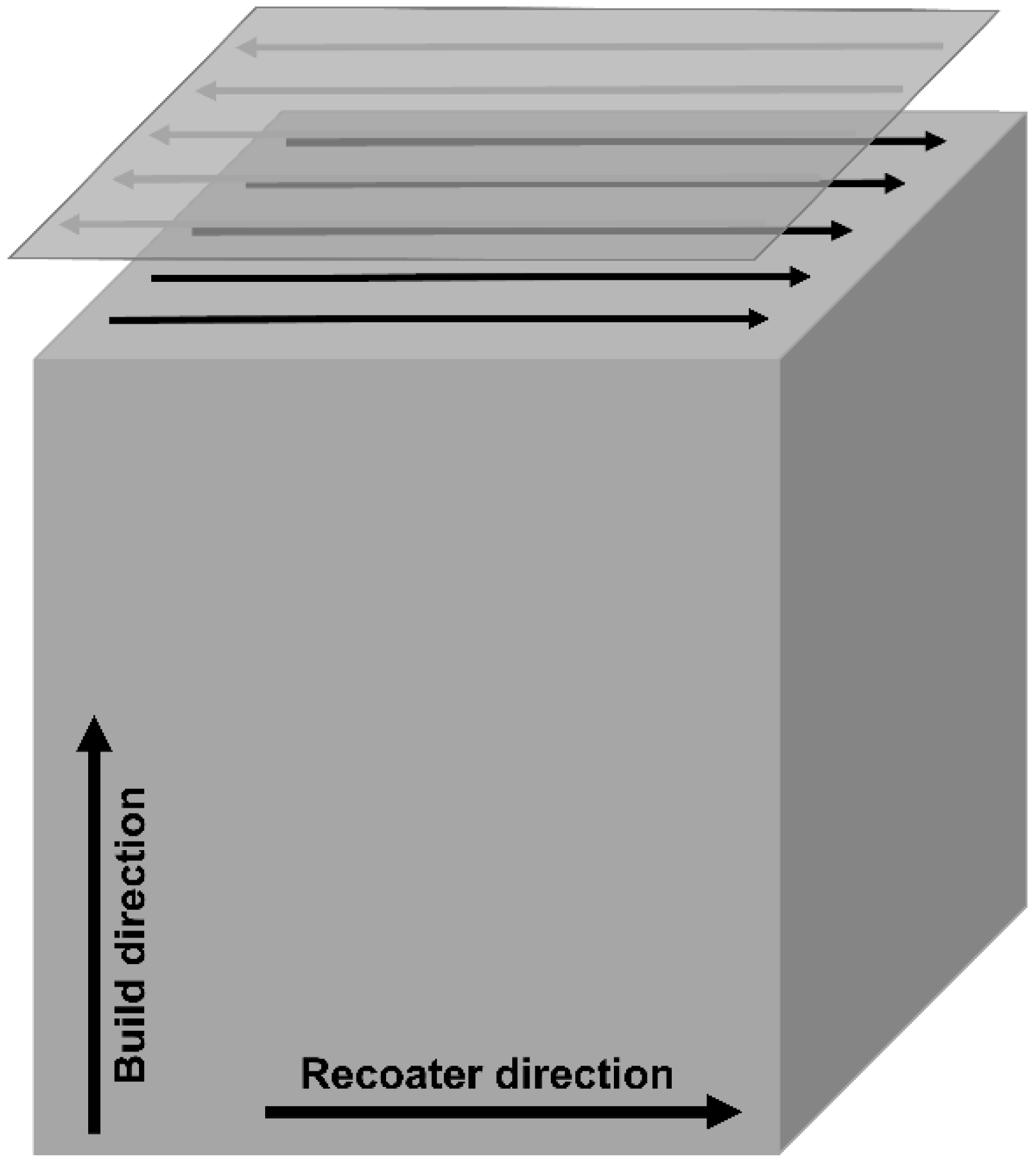
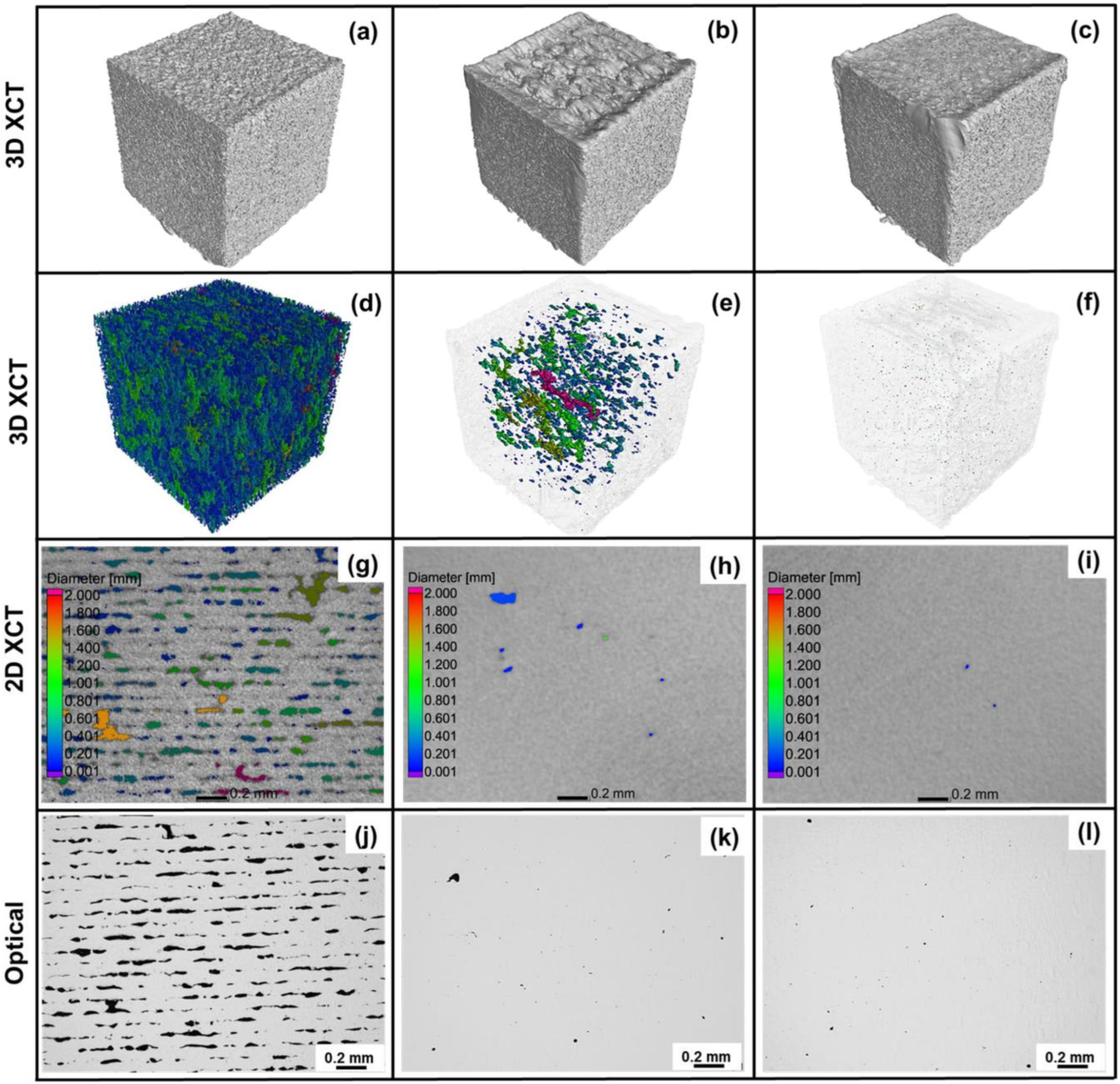
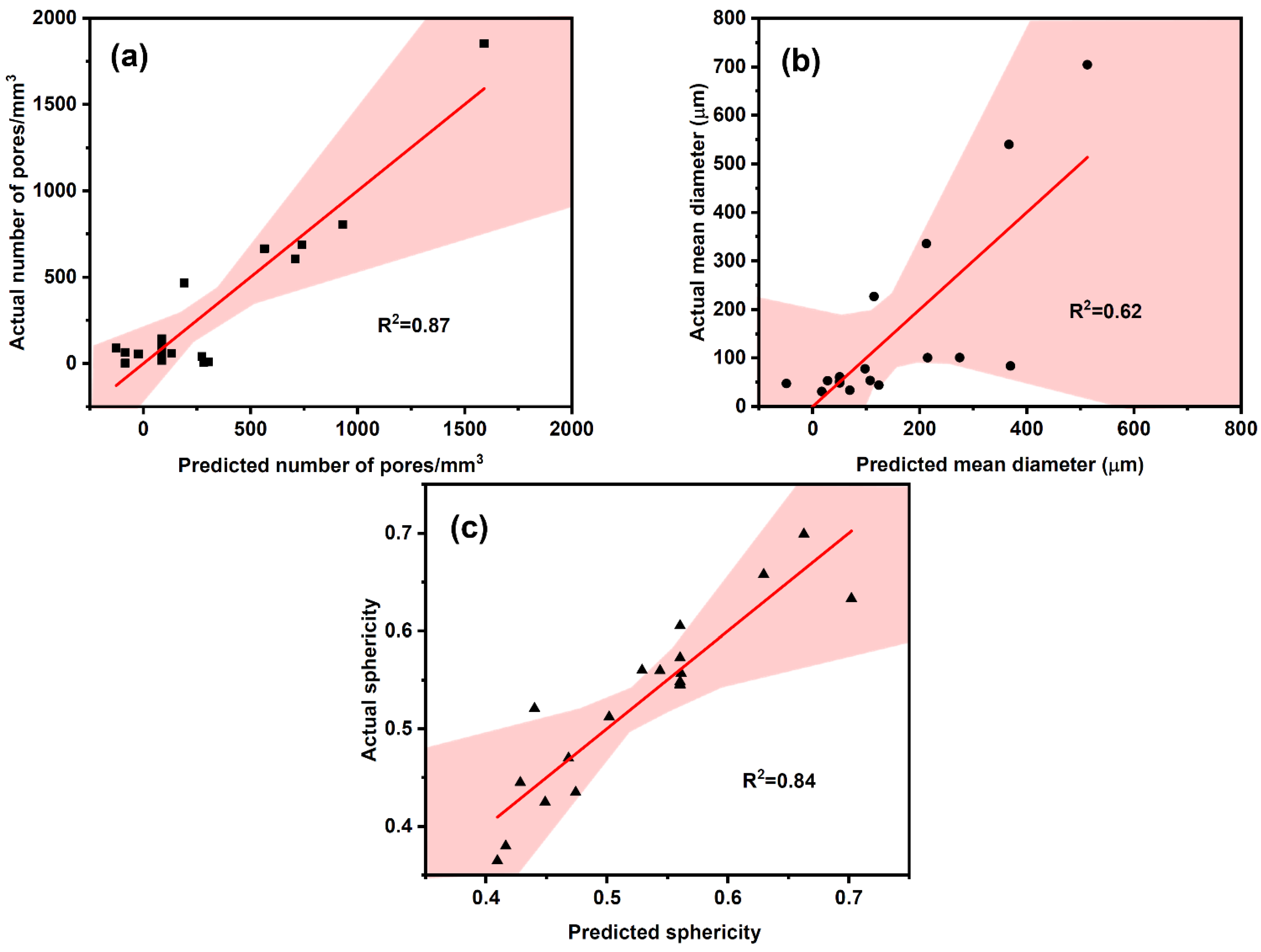
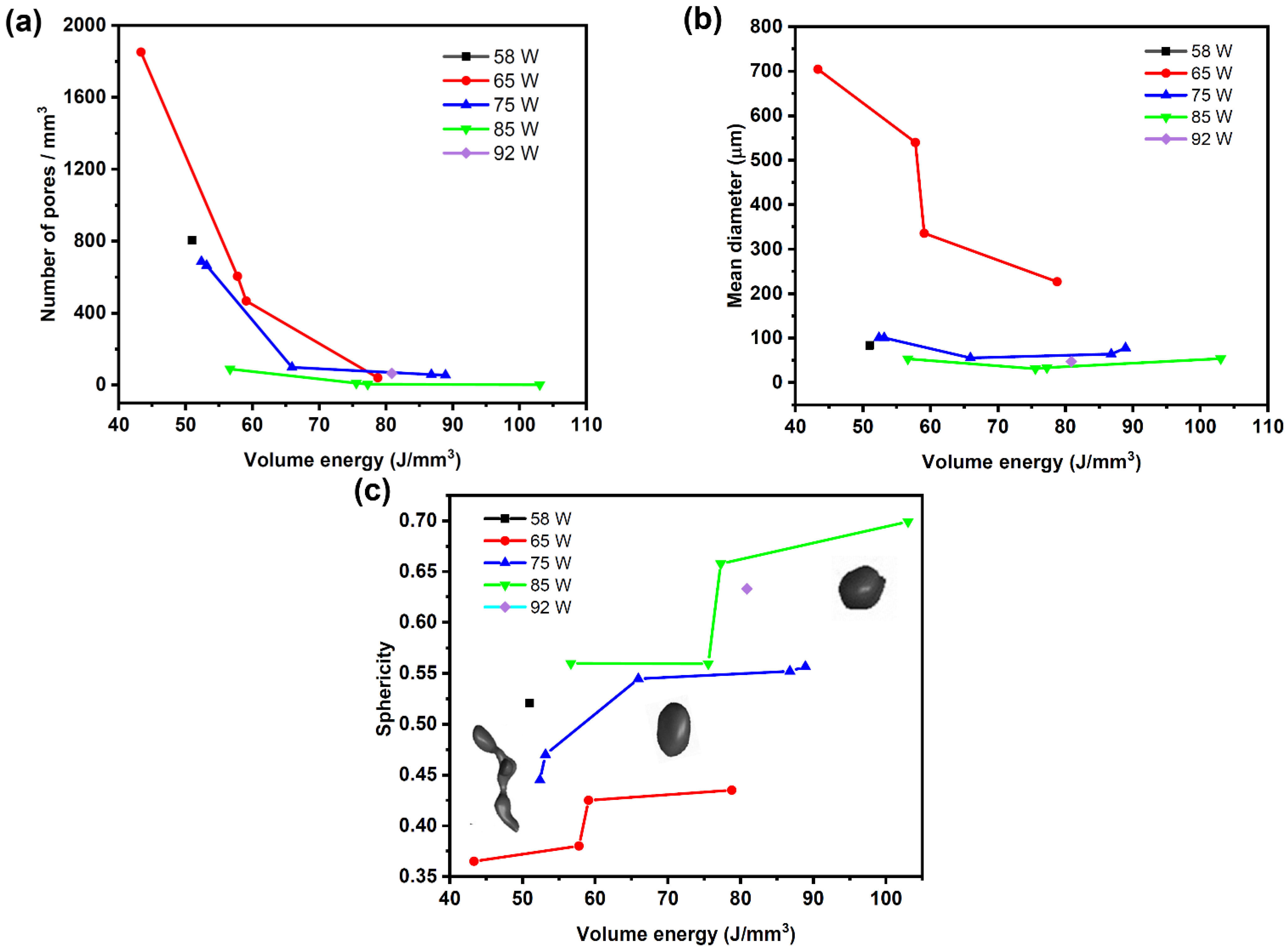
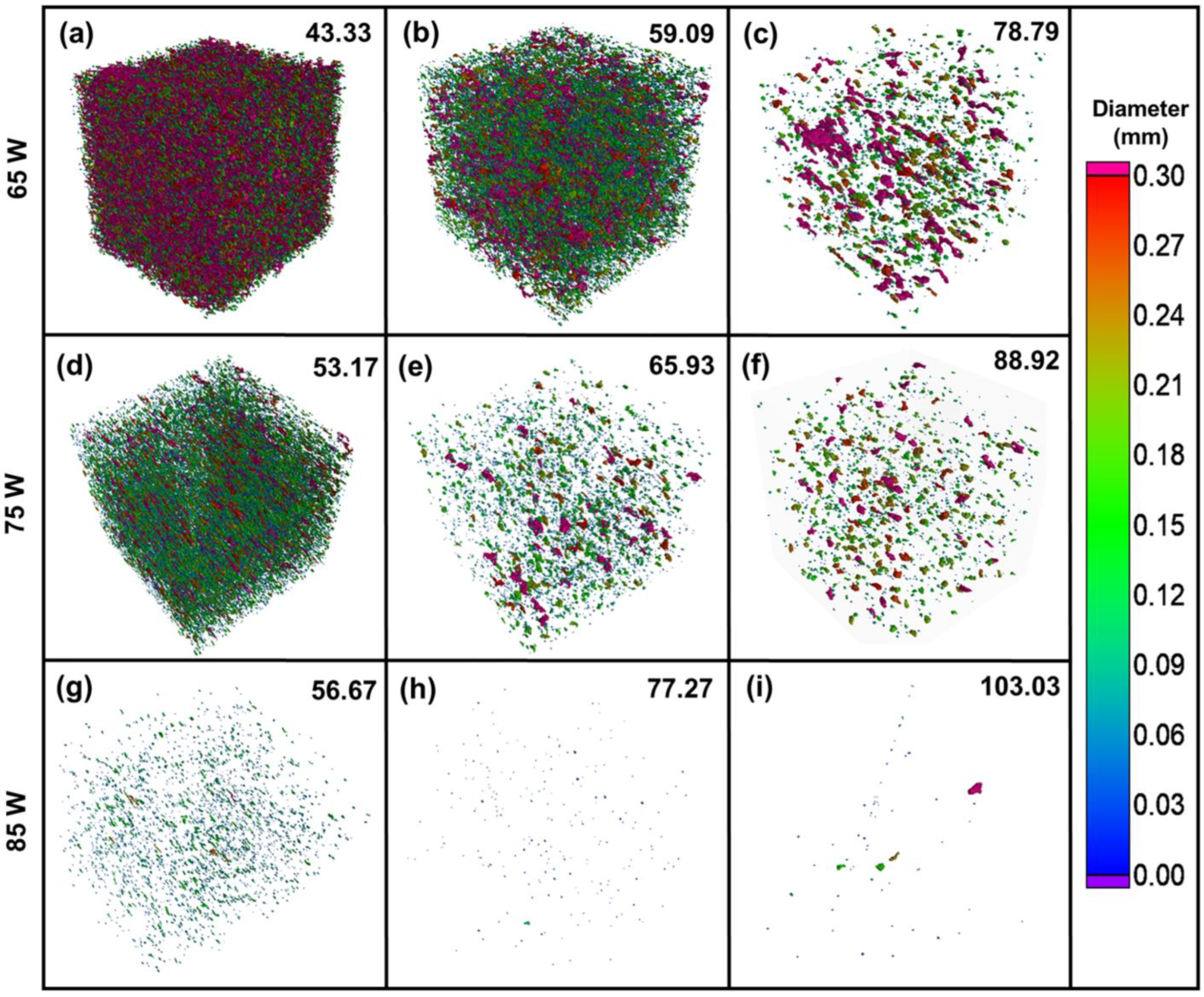
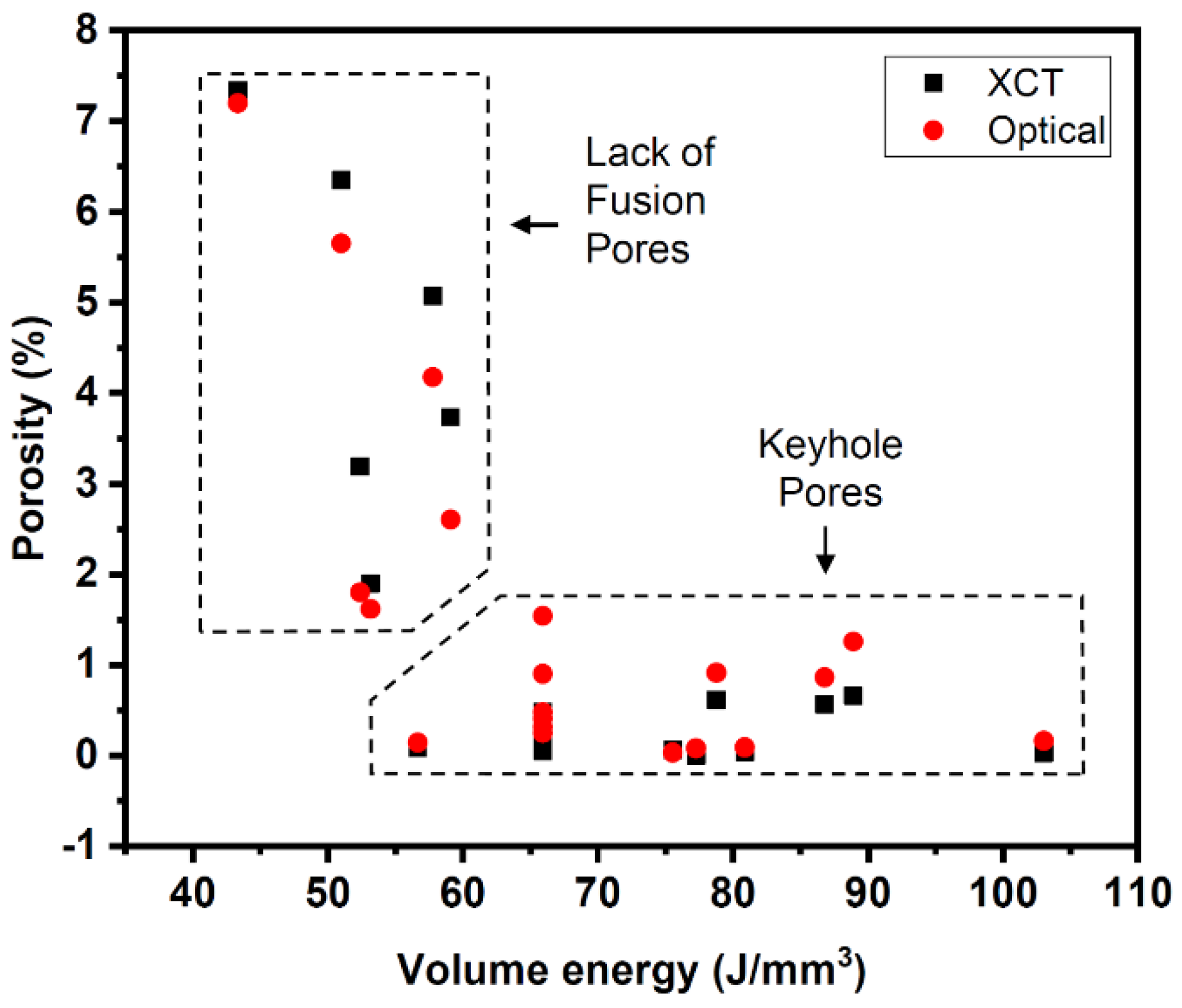
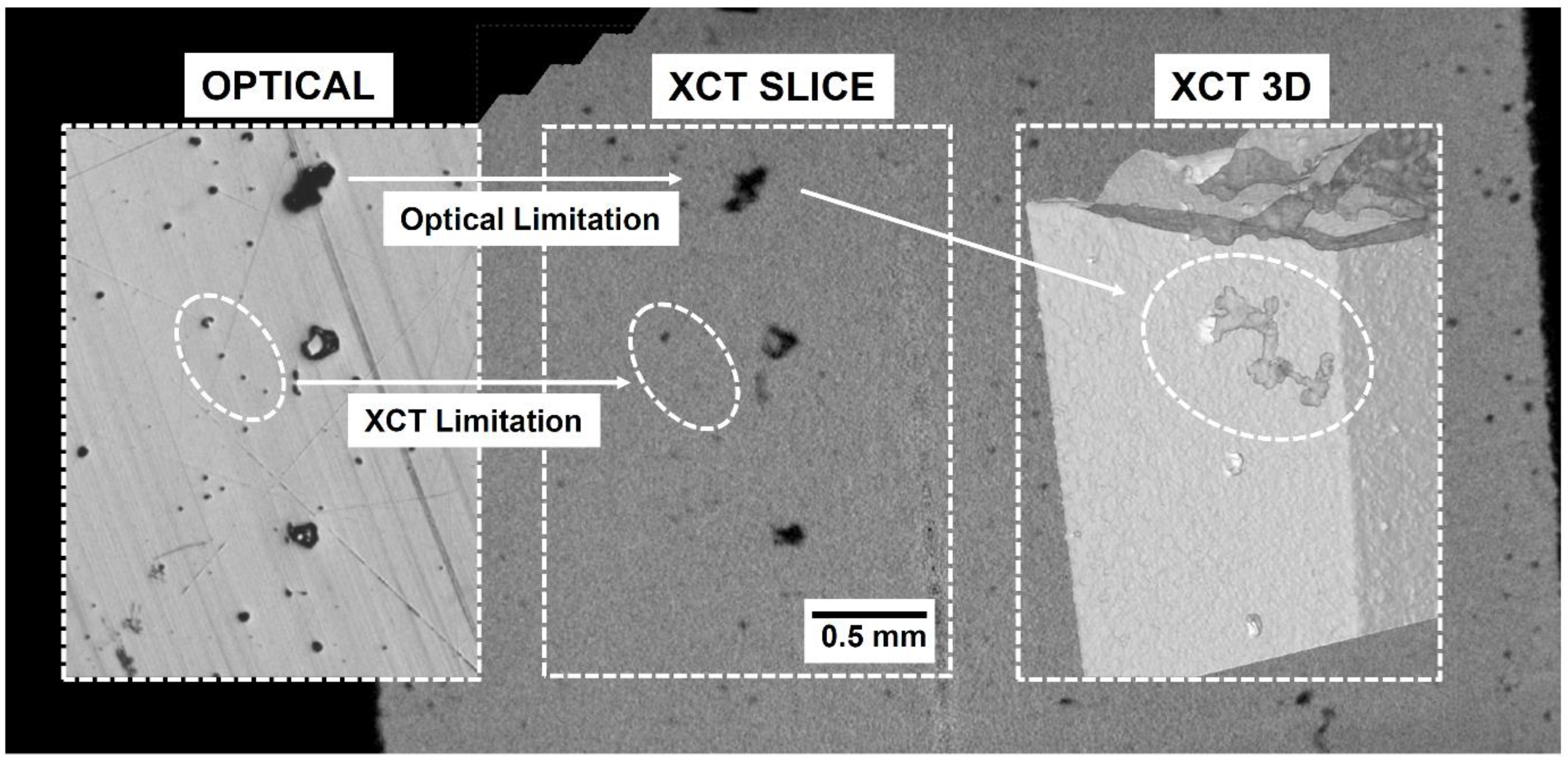
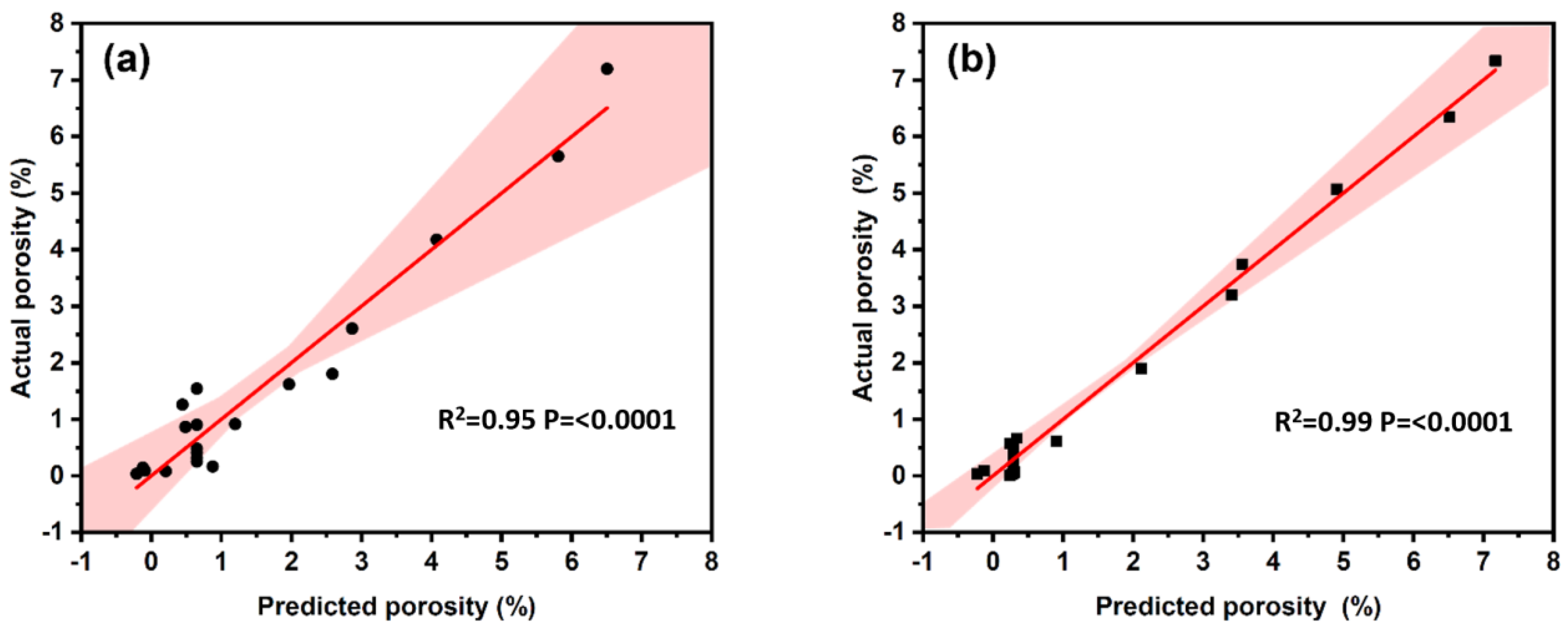
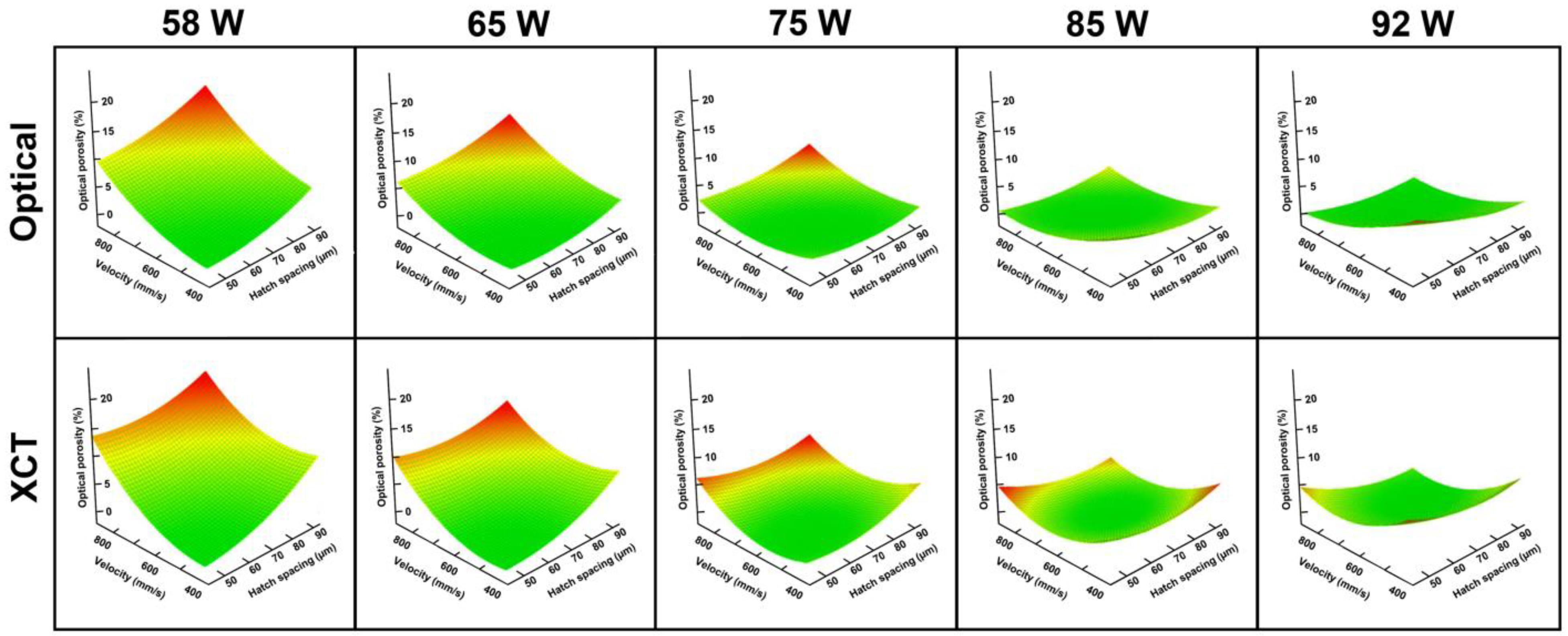

| Sample Number | Power (W) | Velocity (mm/s) | Hatch Spacing (µm) | Volume Energy (J/mm3) |
|---|---|---|---|---|
| 1 | 65 | 750 | 80 | 43.33 |
| 2 | 75 | 650 | 70 | 65.93 |
| 3 | 85 | 750 | 60 | 75.56 |
| 4 | 85 | 750 | 80 | 56.67 |
| 5 | 75 | 650 | 70 | 65.93 |
| 6 | 85 | 550 | 60 | 103.03 |
| 7 | 65 | 750 | 60 | 57.78 |
| 8 | 75 | 650 | 70 | 65.93 |
| 9 | 58 | 650 | 70 | 50.99 |
| 10 | 65 | 550 | 60 | 78.79 |
| 11 | 65 | 550 | 80 | 59.09 |
| 12 | 75 | 650 | 70 | 65.93 |
| 13 | 85 | 550 | 80 | 77.27 |
| 14 | 75 | 650 | 70 | 65.93 |
| 15 | 75 | 650 | 86.81 | 53.17 |
| 16 | 92 | 650 | 70 | 80.88 |
| 17 | 75 | 650 | 53.18 | 86.79 |
| 18 | 75 | 482 | 70 | 88.92 |
| 19 | 75 | 818 | 70 | 52.39 |
| 20 | 75 | 650 | 70 | 65.93 |
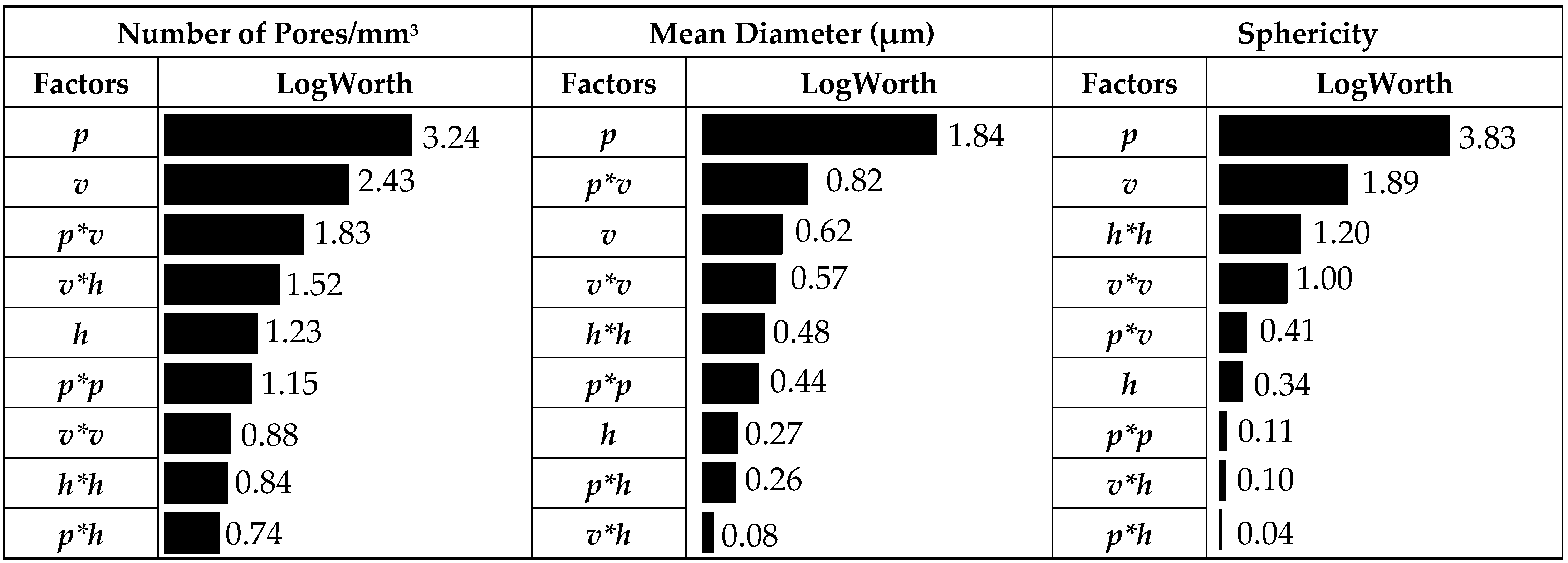 |
| (a) | ||||
| Factors | Reg. coe. | F ratio | p-value | LogWorth |
| Power | −0.17356 | 100.7724 | <0.00001 |  |
| Power*Power | 0.00764 | 21.1278 | 0.00099 |  |
| Power*Velocity | −0.00099 | 19.0476 | 0.00141 |  |
| Velocity | −0.00638 | 13.4630 | 0.00432 |  |
| Power*Hatch spacing | −0.00585 | 6.6498 | 0.02748 |  |
| Hatch spacing | 0.04401 | 6.4209 | 0.02967 |  |
| Velocity*Velocity | 0.00003 | 3.2778 | 0.10032 |  |
| Hatch spacing*Hatch spacing | 0.00204 | 1.4589 | 0.25489 |  |
| Velocity*Hatch spacing | 0.00019 | 0.7055 | 0.42058 |  |
| (b) | ||||
| Factors | Reg. coe. | F ratio | p-value | LogWorth |
| Power | −0.19815 | 566.9653 | <0.00001 |  |
| Power*Power | 0.00986 | 152.0352 | <0.00001 |  |
| Velocity | 0.00910 | 118.5320 | <0.00001 |  |
| Power*Velocity | −0.00099 | 82.5550 | <0.00001 |  |
| Velocity*Velocity | 0.00005 | 47.2632 | 0.00004 |  |
| Hatch spacing | 0.05584 | 44.6194 | 0.00006 |  |
| Power*Hatch spacing | −0.00674 | 38.0917 | 0.00011 |  |
| Hatch spacing*Hatch spacing | 0.00314 | 14.9290 | 0.00314 |  |
| Velocity*Hatch spacing | −0.00010 | 0.8379 | 0.38154 |  |
| Method | Power (W) | Velocity (mm/s) | Hatch Spacing (μm) | Volume Energy (J/mm3) | Predicted Porosity (%) | Measured Porosity (%) |
|---|---|---|---|---|---|---|
| Optical | 92 | 817 | 76 | 59.27 | −1.198 | 0.0009 |
| XCT | 92 | 750 | 81 | 60.58 | −0.925 | 0.0003 |
Disclaimer/Publisher’s Note: The statements, opinions and data contained in all publications are solely those of the individual author(s) and contributor(s) and not of MDPI and/or the editor(s). MDPI and/or the editor(s) disclaim responsibility for any injury to people or property resulting from any ideas, methods, instructions or products referred to in the content. |
© 2023 by the authors. Licensee MDPI, Basel, Switzerland. This article is an open access article distributed under the terms and conditions of the Creative Commons Attribution (CC BY) license (https://creativecommons.org/licenses/by/4.0/).
Share and Cite
Zhao, R.; Shmatok, A.; Fischer, R.; Prorok, B.C. Investigation of Causal Relationships between Printing Parameters, Pore Properties and Porosity in Laser Powder Bed Fusion. Metals 2023, 13, 330. https://doi.org/10.3390/met13020330
Zhao R, Shmatok A, Fischer R, Prorok BC. Investigation of Causal Relationships between Printing Parameters, Pore Properties and Porosity in Laser Powder Bed Fusion. Metals. 2023; 13(2):330. https://doi.org/10.3390/met13020330
Chicago/Turabian StyleZhao, Rong, Andrii Shmatok, Ralf Fischer, and Barton C. Prorok. 2023. "Investigation of Causal Relationships between Printing Parameters, Pore Properties and Porosity in Laser Powder Bed Fusion" Metals 13, no. 2: 330. https://doi.org/10.3390/met13020330
APA StyleZhao, R., Shmatok, A., Fischer, R., & Prorok, B. C. (2023). Investigation of Causal Relationships between Printing Parameters, Pore Properties and Porosity in Laser Powder Bed Fusion. Metals, 13(2), 330. https://doi.org/10.3390/met13020330






